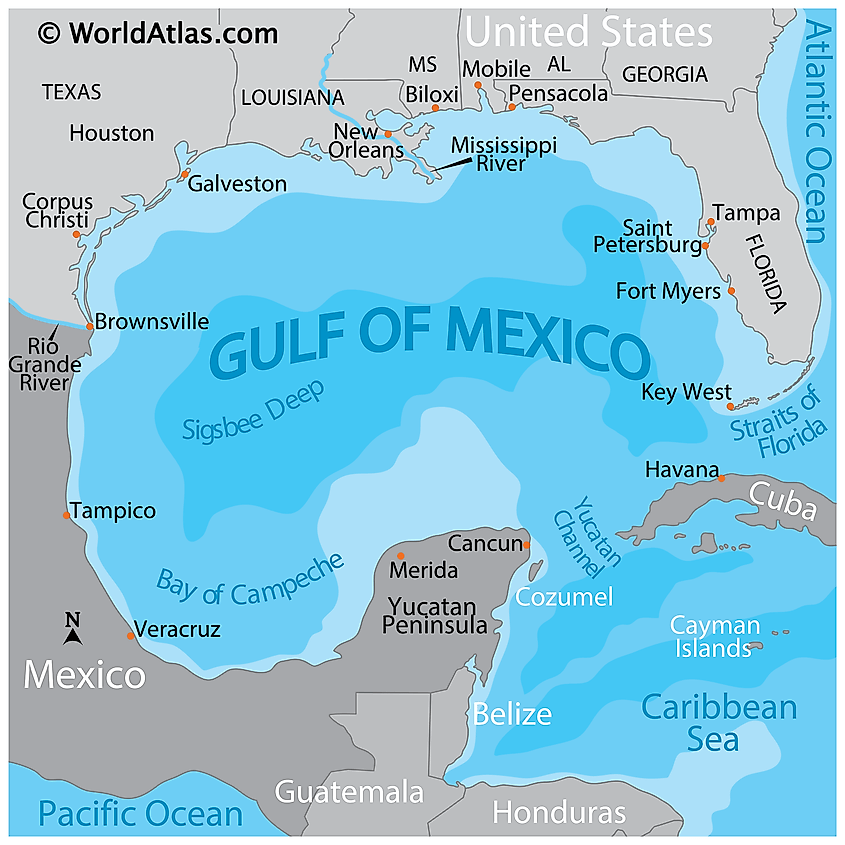The Gulf of Mexico is a unique and fascinating region that has been shrouded in myths and misconceptions for centuries. From its supposed danger to the idea that it is nothing more than a giant oil field, there are many myths and misunderstandings about the Gulf that persist to this day. In this article, we will take a closer look at the top 10 myths about the Gulf of Mexico and separate fact from fiction.
List of the Top 10 Myths About the Gulf of Mexico
- Myth 1: The Gulf of Mexico is nothing but a giant oil field
- Myth 2: The Gulf of Mexico is too dangerous to visit
- Myth 3: The Gulf of Mexico is a polluted wasteland
- Myth 4: The Gulf of Mexico is only of interest to scientists and environmentalists
- Myth 5: The Gulf of Mexico is always warm and sunny
- Myth 6: The Gulf of Mexico is a single, homogenous region
- Myth 7: The Gulf of Mexico is completely flat and featureless
- Myth 8: The Gulf of Mexico is not important to the rest of the world
- Myth 9: The Deepwater Horizon disaster was the worst environmental disaster in the history of the Gulf of Mexico
- Myth 10: The Gulf of Mexico is a static, unchanging environment
Myth 1: The Gulf of Mexico is nothing but a giant oil field
While the Gulf of Mexico is certainly an important source of oil and gas for the United States, it is far from being nothing more than a giant oil field. The Gulf is home to a diverse range of marine life, including whales, dolphins, sea turtles, and a wide variety of fish and shellfish. It is also a popular destination for tourists, who come to enjoy its warm waters, sandy beaches, and rich cultural heritage.
Myth 2: The Gulf of Mexico is too dangerous to visit
While the Gulf of Mexico is certainly subject to some dangerous weather conditions, such as hurricanes and tropical storms, it is generally a safe place to visit. The vast majority of the region’s beaches and waters are safe for swimming and other recreational activities. Visitors should always exercise caution and pay attention to local weather reports, but there is no need to avoid the Gulf altogether out of fear.
Myth 3: The Gulf of Mexico is a polluted wasteland
While there are certainly environmental challenges facing the Gulf of Mexico, including pollution and overfishing, it is far from being a polluted wasteland. In fact, the Gulf is home to a wide variety of healthy and thriving ecosystems, including coral reefs, seagrass beds, and oyster reefs. Efforts to protect and restore these ecosystems are ongoing, and progress is being made in reducing pollution and other environmental threats.
Myth 4: The Gulf of Mexico is only of interest to scientists and environmentalists
While the Gulf of Mexico is certainly an important area of study for scientists and environmentalists, it is also of interest to a wide variety of people. For example, the Gulf is home to a rich cultural heritage, including unique culinary traditions and vibrant music scenes. It is also an important economic engine, supporting industries like fishing, tourism, and oil and gas production.
Myth 5: The Gulf of Mexico is always warm and sunny
While the Gulf of Mexico is certainly known for its warm waters and sunny beaches, it is not always warm and sunny. The region experiences a wide range of weather conditions, from hot and humid summers to cool and breezy winters. Visitors should be prepared for a range of weather conditions depending on the time of year they visit.
Myth 6: The Gulf of Mexico is a single, homogenous region
While the Gulf of Mexico is often referred to as a single entity, it is actually a complex and diverse region with many different ecosystems and communities. From the sandy beaches of Florida to the marshy wetlands of Louisiana, the Gulf is home to a wide variety of habitats and cultures.
Myth 7: The Gulf of Mexico is completely flat and featureless
While the Gulf of Mexico is certainly not as mountainous as other regions of the United States, it is far from being completely flat and featureless. The Gulf is home to a wide variety of underwater features, including canyons, ridges, and seamounts. These features are important habitats for many species of marine life.
Myth 8: The Gulf of Mexico is not important to the rest of the world
While the Gulf of Mexico may seem like a regional backwater to some, it is actually an important region with global significance. The Gulf is home to a wide variety of migratory species, including birds, fish, and sea turtles, that travel between the Gulf and other parts of the world. It is also an important source of oil and gas for the United States and other countries, making it an important player in global energy markets.
Myth 9: The Deepwater Horizon disaster was the worst environmental disaster in the history of the Gulf of Mexico
While the Deepwater Horizon disaster was certainly a major environmental disaster with far-reaching impacts, it was not the worst disaster in the history of the Gulf of Mexico. The Gulf has a long history of environmental challenges, including oil spills, hurricanes, and pollution from agricultural and industrial activities. Efforts to address these challenges are ongoing, and progress is being made in restoring and protecting the Gulf’s ecosystems.
Myth 10: The Gulf of Mexico is a static, unchanging environment
While the Gulf of Mexico may seem like a stable and unchanging environment, it is actually a dynamic and ever-changing ecosystem. The Gulf is subject to a wide range of natural and human-induced factors that can impact its ecosystems, including climate change, ocean acidification, overfishing, and pollution. Understanding and managing these factors is critical to ensuring the long-term health and sustainability of the Gulf and its many communities.
Bibliography
- Gulf of Mexico Alliance. (2021). About the Gulf of Mexico. Retrieved from https://gulfofmexicoalliance.org/about-the-gulf-of-mexico/
- National Oceanic and Atmospheric Administration. (2021). Gulf of Mexico. Retrieved from https://www.noaa.gov/education/resource-collections/ocean-coasts-education-resources/gulf-of-mexico
- The Nature Conservancy. (2021). Gulf of Mexico. Retrieved from https://www.nature.org/en-us/about-us/where-we-work/united-states/gulf-of-mexico/
- United States Environmental Protection Agency. (2021). Gulf of Mexico Program. Retrieved from https://www.epa.gov/gulfofmexico



 For all latest articles, follow on Google News
For all latest articles, follow on Google News